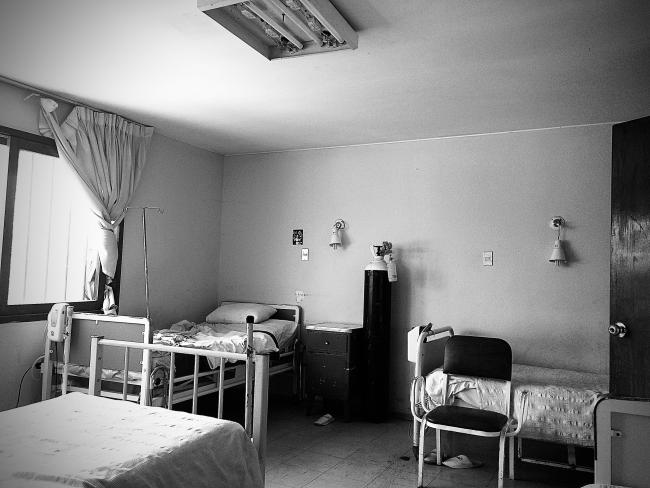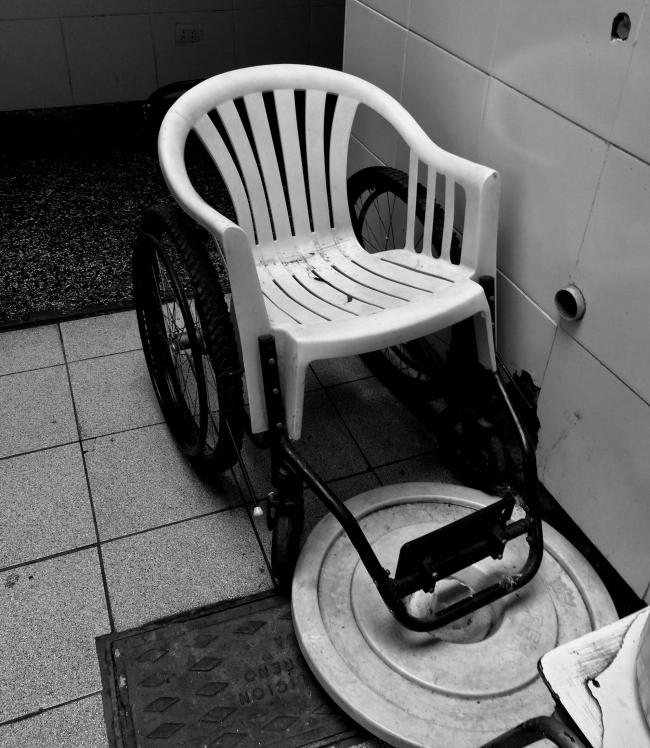
“I would rather die than live in this institution,” Doris confessed when I visited her in November of last year at the nursing home where she is currently living. A few weeks before, she had been accepted as a resident in a dilapidated shelter for older adults in Lima, Peru. When asked if she felt relieved because she was no longer homeless, she said: “No. This is like prison; confinement is killing me. We are invisible old people here. Every night I ask God to take me with Him.”
Doris lives in a residential long-term care facility for older adults administered by Peru’s Ministry for Women and Vulnerable Populations. In Peru, a growing number of people are entering old age, and exposed to ever-increasing social disparities, as I have been able to observe over the course of a decade of ethnographic fieldwork. Older adults in the country comprise 12.7 percent of the total population. Much of this demographic ages in a situation of social and economic precarity, highlighting the inability of the state to guarantee that older people can age with dignity and rights. In fact, my research shows that long-term care facilities place the lives of vulnerable residents at risk given the precarious and negligent care they receive.
Currently, Peru is facing demographic transitions that constitute a challenge to its public institutions; the elderly population is growing rapidly while the national birth rate is steadily decreasing. Moreover, the state is slow to implement mechanisms to address the pressing needs of this vulnerable population. One measure has been the creation of the residential long-term care system, called Older Adult Care Centers (CEAPAM for its Spanish acronym). The long-term-care residential system consists of a number of facilities nationally responsible for providing “comprehensive care and attention to older adults with varying degrees of autonomy, 24 hours a day,” according to the Peruvian Law for Older Adults 30490 approved in 2016.
The ministry promotes an image of residential centers as secure places, where those who have been abandoned by their family or lack financial support can age with dignity. This is outlined in the text of Law 30490, which defines a residential care center as “a public or private space accredited by the state where comprehensive, specialized, and multidisciplinary care services are provided, aimed at self-sufficient or dependent older adults, according to their care needs, promoting their autonomy and independence.” As of April 2021, there were 349 CEAPAM facilities nationwide, consisting of 292 private and 57 public centers.
While in discourse these places promise to allow those on the margins to have fulfilling lives, residents experience these institutions as coercive, surveilled, and neglectful. In Lima, these so-called care institutions are in practice failing older adults because they do not provide a space for quality care, the personal aspirations of the residents are not taken into consideration, and residents are kept locked up, under the claim that it is for their protection. In short, “promoting autonomy and independence” rarely happens, according to the testimony of several people I was able to meet at these facilities.
“I Wanted Another Kind of Ending for My Life”
Smiling discreetly to soften her suffering, Doris talked about the emotional discomfort that confinement has caused her, explaining that she’s not permitted to work or leave the center. “They don't let me step out onto the street. I need to see people, see life. Here they give me food and a roof, but it is not enough,” Doris said. “I feel suffocated, and I get depressed. I want to go to a park, see the sea… I have no freedom in my old age.”
The institution where Doris resides does not take into account that she is still a self-sufficient person who can go out for a walk, perhaps accompanied by members of the residence’s staff. Instead, what these so-called spaces for social protection do is standardize care. This means that if there are residents with disabilities who cannot go outside the institution, this limitation applies to everyone, even those who are in good health. Consequently, self-sufficient people like Doris end up disadvantaged by these rigid protocols.
Antonio, another resident whom I met through Doris, told me that these state-run institutions do not fulfill their mission. “When they bring us in, they tell us that the Ministry aims to reinsert us into society. But they don't,” Antonio told me with a mischievous look. I asked Antonio what would need to happen for residents to be reintegrated into society. “Let us work!” he exclaimed. “Doing so, I would feel useful and independent. I can work, I have done it all my life. Here they keep us locked down and I feel that my life lacks any purpose.”
Amalia, a tiny mestizo woman who is Doris's roommate, commented on the kind of treatment she receives: “Yesterday I called two nursing technicians to help me carry some bags. They looked at me, turned around, and walked away.” Other revelations from Amalia indicated that the attention provided to residents is inconsistent and precarious, placing individuals at risk. The previous week, she explained, a man died in the dining room during lunch because the nursing technician did not cut up his meat into bite-sized pieces. The man, who could no longer eat on his own and was reliant upon the nurse, choked and asphyxiated in full view of everyone.
While a rudimentary and poorly run state welfare institution is better than living on the streets, we must demand more from our public institutions. At the shelter, Doris, Antonio, and Amalia have some protection from the violence that is prevalent in their neighborhood, they do not go hungry, and if they have a medical need they can access (precarious) assistance. However, the inconsistent and erratic care offered in these institutions not only threatens the lives of these residents, but also subjects them to abuse and suppresses their possibilities for well-being and development. As Doris said to me:
I recognize that if it were not for the institution I would be on the street. But I'm just asking for a little empathy. Just because we live in these places doesn't mean we're trash. We are also human; we also have desires… Those who run these centers should never forget that we are not here because we want to be, but because we have nobody and nothing. I wanted another kind of ending for my life.
What is the point of having institutions to assist the socially vulnerable if they cannot be spaces of compassion and care? Institutions created by the Peruvian state with the aim to protect vulnerable older people are in reality places that at best provide the most basic material needs. In practice, these facilities threaten the physical, mental, and emotional well-being of Peru’s elderly population.

Media Scandals
This claim is evidenced by the multiple scandals that have been uncovered by the Peruvian press revealing how residential long-term care facilities continuously mistreat and neglect their residents. In April 2018, the Peruvian actress Nataniel Sanchez publicly denounced, through her Facebook account, the abuse perpetrated over the preceding decade against her childhood nanny, Maria Montoya, who had been living in the Canevaro Shelter, the largest private facility of its kind in Peru and in Latin America. At this facility, peeling walls, withered gardens, cracked floors, and broken windows weigh heavily on the everyday lives of residents.
The center is managed by a private charitable organization, Lima’s Benevolent Society, and is the site where I conducted ethnographic fieldwork. Sanchez condemned the shocking state in which her mother found her nanny on one of her visits to the institution: “Our nanny was in a deplorable state, completely filthy, with rags instead of diapers, without medical attention for dementia or other ailments, in a complete state of malnutrition (she was skin and bone).” Doctors at a subsequent hospital visit diagnosed Montoya with severe malnutrition, a chronic urinary tract infection, thrombosis due to lack of mobility, and arrhythmia due to lack of adequate care.
Over the following days, Canevaro was visited continuously by public officials from a number of Peruvian government institutions, including the Ministry of Women and Vulnerable Populations, the National Ombudsman, Lima’s Municipal Council, the Judiciary, and Congress. The aim of these visits was to ensure that the institution, now publicly discredited, was implementing the measures urgently required to guarantee a minimum standard of care. While the outcry resulted in Canevaro’s director being fired, no major structural or institutional changes were set in motion by the Ministry of Women and Vulnerable Populations or the management of the shelter itself. Over the course of my research, I witnessed several other examples of unethical behavior on the part of the institution’s staff, although I was also able to observe workers who treated the residents with respect and dignity.
In November 2023, the Latin American news network Infobae ended the year with a terrifying headline: “Horror shelter in Pueblo Libre: older adults had not eaten for three days and were kept doped.” The story was also featured on the popular news program “24 Horas,” broadcast by Panamericana Televisión, which reported that residents of a clandestine long-term care facility in Pueblo Libre, a middle-class neighborhood in Lima, experienced “physical and psychological abuse.” According to the reports, officials had found expired medications, an unsanitary kitchen, and bathrooms in a deplorable state. Medical records or lists of the people housed there were conspicuously absent. The most disturbing aspect was that the residents appeared to have been drugged.
Imagining a Culture of Care
How old people age and die around us says a lot about the societies in which we live. As my ethnographic research demonstrates, the abandonment in which many older people live, the kind of care they receive at these welfare institutions, and the trauma they experience as their personal wishes and demands are neglected, all indicate that Peru—like other places in the world—does not yet possess a culture of care. Care in its multiple forms—including familial security, the possibility of friendship and emotional support, attention based on humane treatment and respect, and being able to die surrounded by others and with human warmth—must be possible for everyone, and not just a few.
Can we, as a society, achieve a culture of care? A measure of care is how we treat our elders and most vulnerable populations. A caring society in the Peruvian context would be one in which our public institutions, rather than enforcing confinement, enable people to find meaning in their lives. Even in later life, it should be possible to have a decent quality of life and hope for a dignified death. Living in a caring society means preserving the human condition, and being acknowledged, listened to, and treated with dignity. As our societies become more and more individualized, we increasingly need institutions where individuals can live out their final days and die in peace. In Peru, we still have a long way to go to achieve this goal.
Only by instituting solidarity mechanisms supported by both family and social networks, as well as by our political systems, can we build a culture of care where older adults are not left behind, and where the institutions they inhabit can assure them a decent quality of life. In a post-pandemic Peruvian context, we must ensure that the current neoliberal ideologies directed at valuing people on account of their economic productivity do not naturalize the disposal of those who inhabit the margins. Only by transcending individualism and building a social and relational paradigm of care can these older men and women occupy their own place in the present and have, finally, the possibility—the power—to be heard, seen, and acknowledged.
Magdalena Zegarra Chiappori holds a PhD in Anthropology from the University of Michigan. Her work is located at the intersections of old age, care, and precarity.

